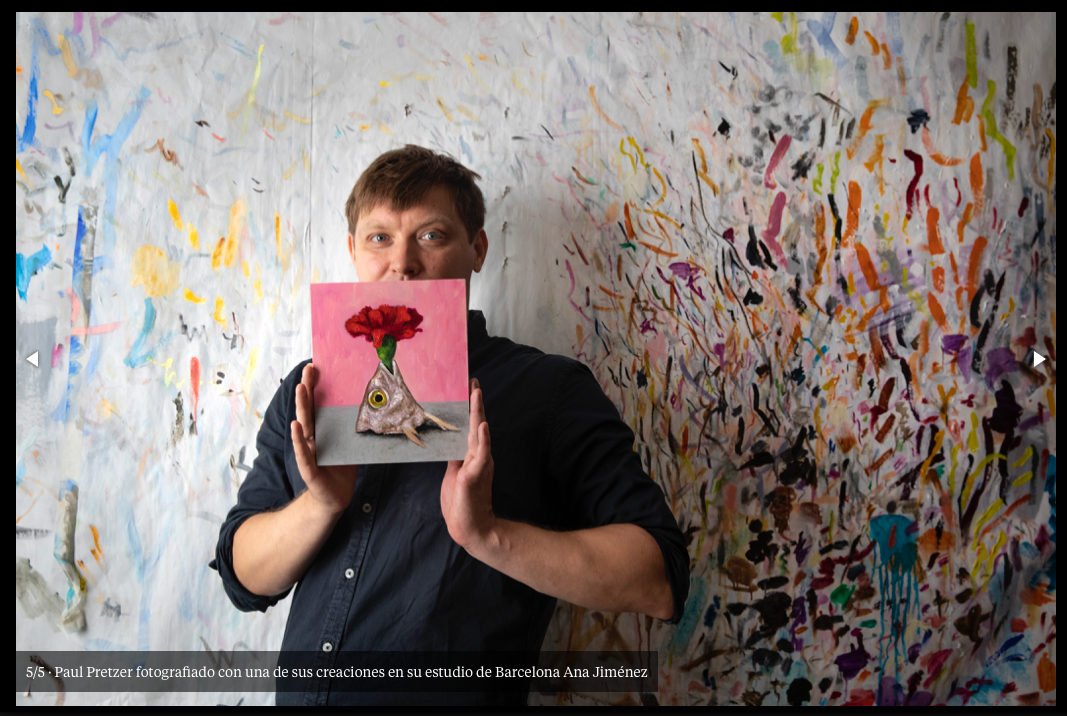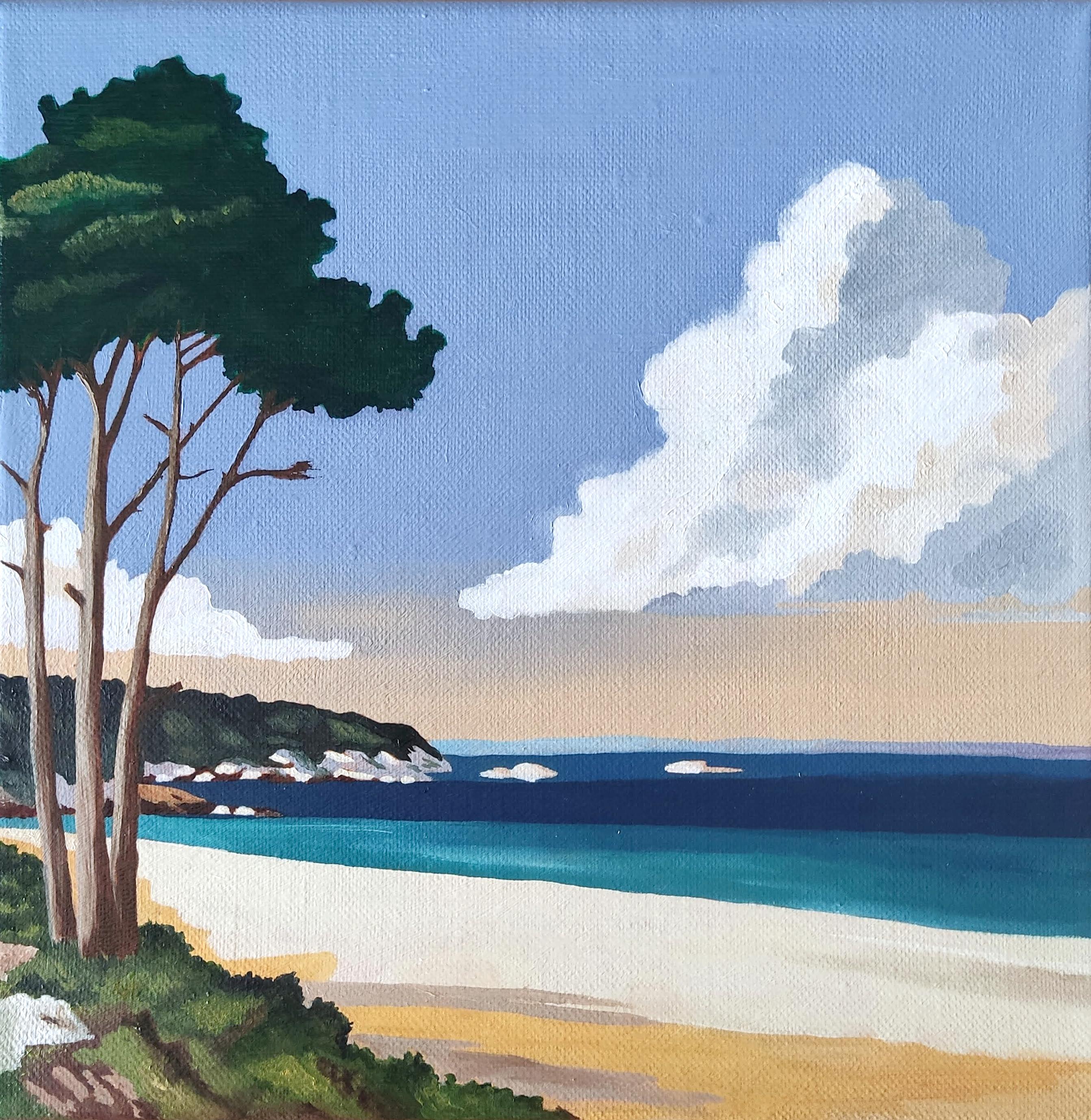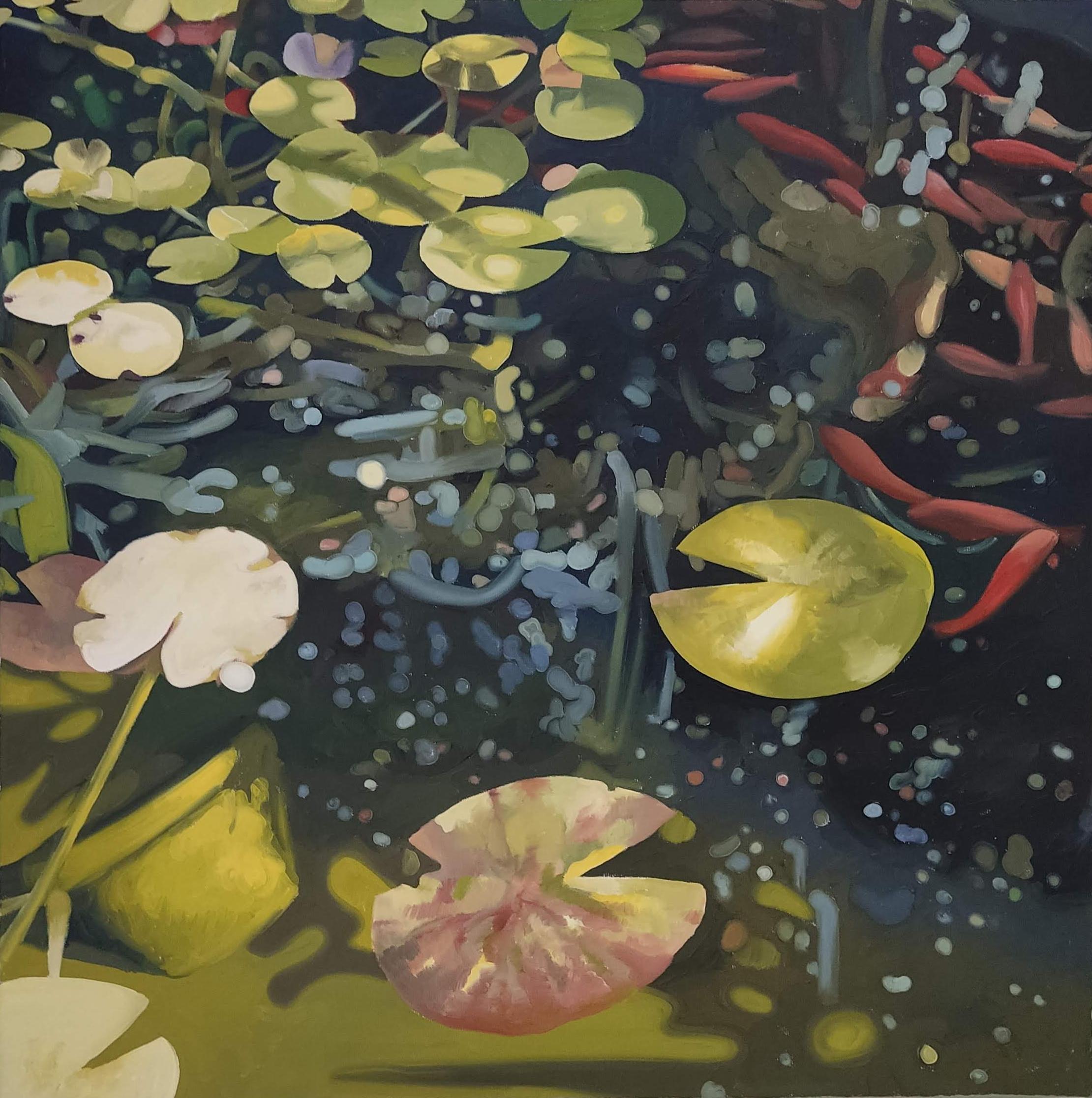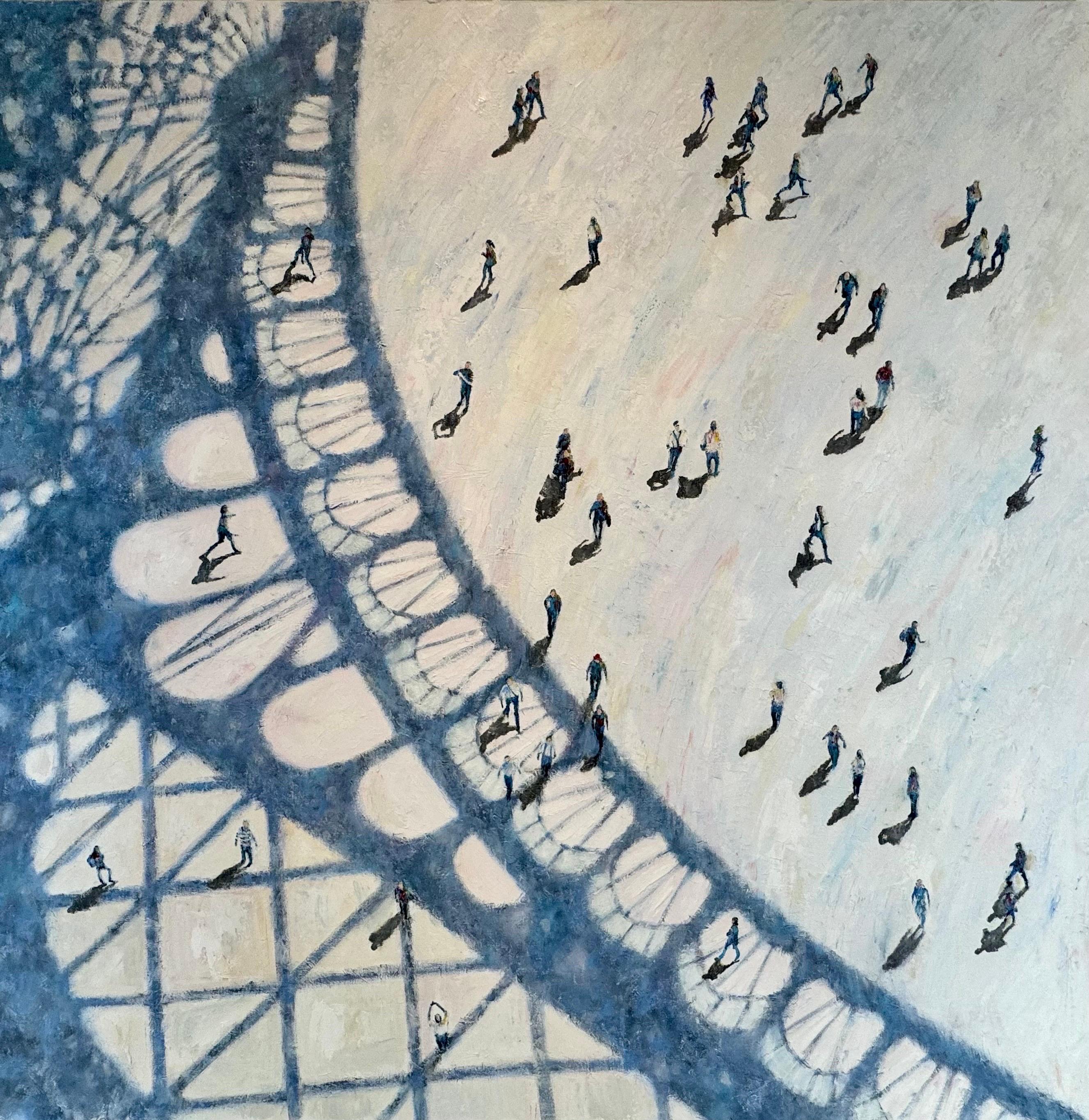Items Similar to Silver Man
Want more images or videos?
Request additional images or videos from the seller
1 of 8
Marc Gonz Silver Man2023
2023
About the Item
MARC GONZ
THE HIDDEN GAZE
When confronted with the universe of Marc Gonz, we discover creations that seem to be the result of a working session of a hyperactive action painter who could not stop feverishly adding layers and layers of paint to the canvas. But these beautiful waterfalls with a profusion of colors are obviously not the work of an uncontrolled improvisation. Instead, as a painter, Marc Gonz carefully applies the chosen touches of color to the surface until they take their final, almost sculptural form. What he wants to achieve is a three-dimensional painting that occupies space and not just covers the wall on which it hangs. The artworks look like the stiffened remnants of his artistic process.
The technique Marc uses is close to the classical painting method called "impasto": he mixes his paint on the canvas itself and applies it in such thick layers that the strokes of the brush or painter's knife are clearly visible. In this way, the painting acquires a special texture and it seems as if the paint emerges from the canvas and grows buirently like some kind of fungus or strange unknown plant. 'Impasto painting' was first discovered as a technical experiment in the 17th century when some Baroque style painters tried to represent the volume in folds of clothes or the texture of jewels. Artists like Rembrandt, Frans Hals, and Diego Velázquez attempted Impasto to skillfully depict the minute details like folds, wrinkled skin or the sparkle of elaborately crafted armor, jewellery, and rich fabrics. We also find it in nineteenth-century landscape, naturalist and romantic painting, where it was used by painters like John Constable to convey the raw, rugged tumble of rocks, soil and cliff faces with a rough, experimental energy. In the twentieth century we see how Van Gogh used it to ‘express the turbulent emotions of his artist’s mind'. Also Fauvists like Maurice de Vlaminck or Andre Derrain brought the technique to their experimental territory.
Expressionist and abstract painters like Pollock, Willem de Kooning, Karel Appel or Frank Auerbach went even further and searched for a direct relation with the action of the body and the application of paint on the canvas, by dripping or smearing the paint on the canvas with their hands. And in fact we can also how nowadays painters like Richter, Kiefer or Peter Doig keep exploring the possibilities of texture in paint.
Most of Marc Gonz's recent works are portraits or fragments of human faces: we recognize the shape, see ears, noses and lips of figures that look like young men. What is striking about all
these works is that behind each of these layers of colored paint we can repeatedly discover a human eye as a kind of underlying, central point. It is the only part of the canvas that seems to have been spared from the aggressive splashes of color. It is as if the person portrayed is looking at us from this virgin place, from underneath the various layers. It is a human eye, buried by the overdose of paint. The person portrayed seems to hide behind a bizarre colorful burden of a mask. The works seem unwilling to reveal their true soul.
The artist sometimes describes his works as "winks of foam”. By a "wink" we mean a blink, the rapid opening and closing of an eye, to greet the viewer and give him a sense of complicity.
It is as if from behind each work someone is looking at us, seeming to want to answer our curiosity, yet observing us from behind its protective colorful camouflage.
Marc's works are clearly portraits of people we identify as anonymous, adolescent or younger men. Sometimes he betrays their origins ("Thai eye"/"Candy man"). They often look a bit like clowns with cone-shaped Pierrot hats on their heads. They seem innocent and friendly freaks that emerge from the artist's imagination. The shape of their heads and their entire faces are covered in color, as if a giant, colorful birthday cake was thrown in their faces. The excessive amount of paint does indeed resemble a colored cake and reminds us of the famous Laurel &
Hardy movie "The battle of the Century" in which more than 3,000 whipped cream cakes were used in an epic cake fight. The figure of the comedian and the clown is a melancholic personnage: at the same time victim of accidents and reason for our laughter. They are tragicomic beings whose lives are made up of laughter and tears. We find the same kind of personnages with the filmmaker David Lynch : the main characters of "The elephant Man" and "Eraserhead" are the same kind of melodramatic and strange peronnages.
Indeed, the contours of their monstrous appearance can be somewhat compared to the faces of Marc staring at us.
Like Lynch Marc is fascinated by the mysterious, the spiritual and the occult. He likes to describe his works as meditative exercises who talk about the spirts hidden behind the colorful façade. The artist invites us as viewers to dive in our subconscious and with our eyes scrap the paint away to discover the hidden soul of each work. This way the eyes that are looking at us from behind the abstract surface will reveal us their secret as an echo.
Erich Weiss
2023
- Creator:Marc Gonz (1974, Spanish)
- Creation Year:2023
- Dimensions:Height: 45.28 in (115 cm)Width: 39.38 in (100 cm)Depth: 5.91 in (15 cm)
- More Editions & Sizes:UniquePrice: $6,120
- Medium:
- Period:
- Framing:Framing Options Available
- Condition:
- Gallery Location:BARCELONA, ES
- Reference Number:1stDibs: LU1988213649412

About the Seller
No Reviews Yet
Vetted Seller
These experienced sellers undergo a comprehensive evaluation by our team of in-house experts.
Established in 2014
1stDibs seller since 2022
- ShippingRetrieving quote...Ships From: BARCELONA, Spain
- Return PolicyA return for this item may be initiated within 10 days of delivery.
More From This SellerView All
- Thai EyeLocated in BARCELONA, ESMARC GONZ THE HIDDEN GAZE When confronted with the universe of Marc Gonz, we discover creations that seem to be the result of a working session of a hy...Category
2010s Figurative Paintings
MaterialsCanvas, Oil
- Cake BoyLocated in BARCELONA, ESMARC GONZ THE HIDDEN GAZE When confronted with the universe of Marc Gonz, we discover creations that seem to be the result of a working session of a hyperactive action painter ...Category
2010s Figurative Paintings
MaterialsOil
- Foam ThaiLocated in BARCELONA, ESMARC GONZ THE HIDDEN GAZE When confronted with the universe of Marc Gonz, we discover creations that seem to be the result of a working session of a hyperactive action painter ...Category
2010s Figurative Paintings
MaterialsOil
- Candy ManLocated in BARCELONA, ESMARC GONZ THE HIDDEN GAZE When confronted with the universe of Marc Gonz, we discover creations that seem to be the result of a working session of a hyperactive action painter ...Category
21st Century and Contemporary Conceptual Figurative Sculptures
MaterialsMixed Media, Oil
- Hidden eyeLocated in BARCELONA, ESMARC GONZ THE HIDDEN GAZE When confronted with the universe of Marc Gonz, we discover creations that seem to be the result of a working session of a hyperactive action painter ...Category
2010s Figurative Paintings
MaterialsOil
- Cake SugarLocated in BARCELONA, ESMARC GONZ THE HIDDEN GAZE When confronted with the universe of Marc Gonz, we discover creations that seem to be the result of a working session of a hyperactive action painter ...Category
2010s Figurative Paintings
MaterialsOil
You May Also Like
- Portrait of Jean-Baptiste Greuze, painted on linen by his daughter Anna GreuzeLocated in PARIS, FRThis replica of the last self-portrait of Jean-Baptiste Greuze painted in 1804, executed by his daughter Anna at her father's side and recently rediscovered, provides us with a poignant image of the great artist, represented with panache despite the disillusions of life. 1. Jean-Baptiste Greuze Jean-Baptiste Greuze was the sixth child of a roofer from Tournus and retained a certain rusticity in his behaviour from his provincial childhood, beyond his taste for describing picturesque scenes of the countryside. He initially started training with a little-known painter from Lyon, Charles Grandon, before his genius was recognised in Paris where he became a full-time student of the Académie (of Painting) in 1755. He exhibited his work for the first time at the Salon during the summer of 1755, before leaving on a trip to Italy in the company of Louis Gougenot, abbot of Chezal-Benoît. Upon his return to Paris, Greuze became a prolific painter, participating widely in the Salons held between 1759 and 1765, to which he sent no less than 63 paintings: numerous genre scenes (The Marriage Contract, The Beloved Mother), but also portraits of his family circle, of courtiers and art lovers, or of his colleagues. The Academy closed the doors of the Salons to him in 1767 for not having produced his reception piece within six months of his reception, as was the tradition. He worked actively on this painting (Emperor Severus rebukes Caracalla, his son, for trying to assassinate him ) until the summer of 1769, tackling historical and mythological subjects for the first time. Once this was completed, he was then fully admitted to the Academy, but as a genre painter, and not as an historical painter, which had been one of the greatest humiliations of his life. Greuze then refused any participation in events organised by the Academy or its successor, the Academy of Fine Arts until 1800. Abandoning history painting, he gave a new twist to genre scenes, bringing them closer to history painting, as in this pair of canvases which constitutes some of his masterpieces: The Paternal Curse: The Ungrateful Son and The Paternal Curse: The Punished Son . Married in 1759 to Anne-Gabrielle Babuti, the daughter of a Parisian bookseller, his marriage was unhappy and his wife probably frequently unfaithful. The institution of divorce enabled him to record their separation in 1793, keeping his two daughters Anna-Geneviève, born in April 1762, and Louise-Gabrielle, born in May 1764, with him. Little is known about his daughter Anna except that she was herself a painter and lived with her father until his death. It is likely that most of the paintings she produced up to that date were attributed to her father, whose technique she shared to a great extent, making it extremely difficult to establish an autonomous corpus of her paintings. Greuze died in his studio at the Louvre on March 21st 1805. The attention paid to the expressivity of his characters and the emotional charge they convey enabled Jean-Baptiste Greuze to enjoy immense popularity with the eighteenth-century public, and they still constitute Greuze's true modernity. As the artist said, "I dipped my brush in my heart". Greuze was also an exceptional draughtsman and a portraitist of immense talent and exceptional longevity who painted both the Dauphin (the son of Louis XV and father to Louis XVI) and the young Napoleon Bonaparte. 2. Greuze's self-portraits Greuze was very much influenced by Dutch paintings during all his life. While the source of his inspiration for genre scenes can be found in Gerard Dou...Category
Early 1800s Old Masters Portrait Paintings
MaterialsLinen, Oil
- Bord de mer, Oil Painting on Canvas, Seaside, Contemporary Landscape, BeachLocated in AIX-EN-PROVENCE, FRWork : Original Oil Painting, Handmade artwork, Unique Work. Framed in Solid wood frame with light finish. Ready to Hang. Medium : Oil painting on Linen Canvas. Artist : Gabriel Rie...Category
21st Century and Contemporary Contemporary Landscape Paintings
MaterialsCanvas, Oil, Linen
- Bassin, Original Oil Painting on Canvas, Water lily, Plant, Water, GoldfishBy Raphaël RenaudLocated in AIX-EN-PROVENCE, FROil on linen canvas - Water lily, Plant, Water, Goldfish Work Title : Bassin (EN : Water Basin) Artist : Raphaël Renaud (French artist, Born in 1974, li...Category
21st Century and Contemporary Impressionist Landscape Paintings
MaterialsOil, Canvas, Linen
- Shadows & Light Paris IVBy Eline de JongeLocated in AMSTERDAM, NHOil painting on Belgian linen canvas. Very layered with subtle colours showing the sunlight. It depicts the cast shadow of the Eiffel Tower on a sunny day and the people walking in t...Category
2010s Contemporary Figurative Paintings
MaterialsCanvas, Linen, Oil
- Oil Painting / Photorealism / Figurative Art / Human Figure /MuseumBy Bruce AdamsLocated in Buffalo, NYBruce Adams was a painter, art educator, and writer. Born in Buffalo, N.Y., in 1952, he received a B.S. in 1976 and an M.A. in 1983 from Buffalo State College. Adams’s work is included in numerous private and museum collections, among them the Burchfield-Penney Art Center, the Albright-Knox Art Gallery, the Castellani Art Museum of Niagara University, and the UB Anderson Gallery (all of which are located in Western New York...Category
2010s Realist Figurative Paintings
MaterialsOil, Linen
- Coccinelle No.2Located in PARIS, FRCircular oil and acrylic painting by artist Wenyu Zhu. This work shows a peaceful summer scenery, in which two ladybirds are staying within the flowers. One is staying on the flower ...Category
21st Century and Contemporary Contemporary Figurative Paintings
MaterialsCanvas, Linen, Oil, Acrylic
Recently Viewed
View AllMore Ways To Browse
Frank Stella Del Mar
Franklin Ndibam
Georgina Clapham
Gian Marco Capraro On Sale
Girl Blowing Bubble
Gold Flight Wallpaper
Gucci Trash
Guy Boudro
Irving R Wiles
Louis Vuitton Coming Of Age
Michael Byron
Oladire Araireoluwa
Olomola Tobi
Patrick Nevins
Polo Gear
Samuel C Guy
Vintage Raggedy Ann Dolls
American Primitive Quilt




